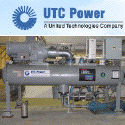Archive for April, 2007
Drilling continues at Blue Mountain
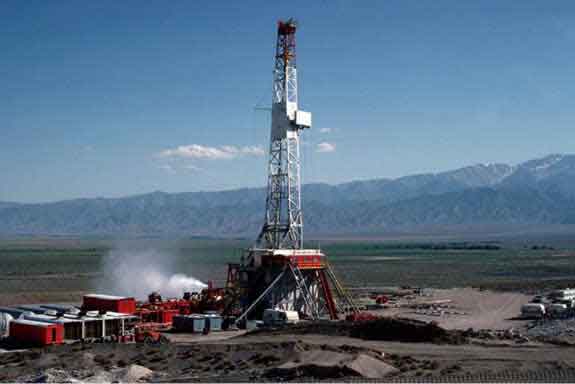
Nevada Geothermal Power issued a release today outlining plans for more drilling on the Blue Mountain project. One of the more difficult and risky activities in any geothermal project is the drilling phase which costs an average of $1,300 per meter drilled for production wells. NGP announced that it has engaged ThermaSource to commence drilling activities May 1 of this year and that they will extend well #38-14 from it’s present depth of just over 600m (~2,000 feet) to just under 1,100m (~3,500 feet.) If necessary, a second production well will be drilled to tap the resource. Our estimate for costs for this activity could range from $650,000 to $1,950,000.
Our research shows that the average production well is capable of producing 4MW of output, this is dependent on resource temperature, pressure, and flow rates. The best known producing geothermal wells are in Iceland with an output of 15MW per well. The Blue Mountain project has a most likely field production estimate created by Geothermex of 47MW. Thus, to fully harvest the field, we estimate NGP will need to drill between 10-12 production wells and at least 3 injection wells. Given that the field depth is between 600 and 1200 meters, we estimate the drilling cost for the total project to come in between $17M and $21M if all of the drilled wells are productive.
Ocean Mechanical Harvest in Practice

From Renewable Energy News:
A pilot project in New York’s East River is evaluating the use of underwater turbines to generate electricity. If the project bears fruit, the technology could have widespread applications. The effort, formally called New York’s Roosevelt Island Tidal Energy Project, is being conducted by Verdant Power and the New York State Research & Development Authority.
As part of the project, Con Edison is using the electricity produced by the turbines to power a grocery store and parking garage on Roosevelt Island, which sits adjacent to midtown and upper Manhattan in the middle of the East River.
For information more information on ocean energy harvest, check our archives on ocean mechanical and thermal conversion posted last week.
1 comment
Southern California Edison inks PPA with Calpine
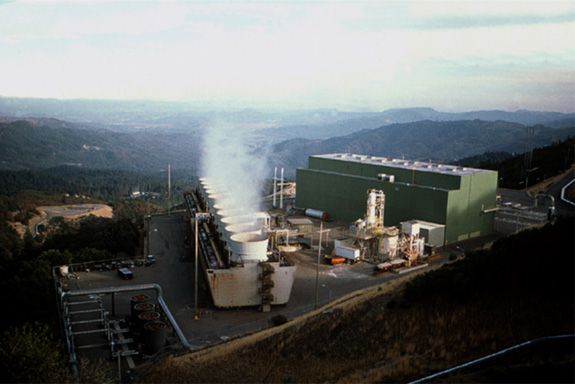
Edison agreed to buy 225MW of geothermal power from Calpine today, which should help SCE meet the 20% RPS by 2010 along with large, recent wind purchases. The power purchase agreement still needs approval from the California Public Utilities Commission before it can go into effect.
Mechanical Ocean Energy Conversion, Part II
Having already explored Ocean Thermal Energy Conversion and the reservoir approach to mechanical ocean energy harvest, it’s time to look at the wave action harvest technologies and companies.
This is pretty simple, the energy in the ocean (generated by wind, convection, and lunar gravitational pull) is expressed in waves and currents. One can clearly see the power of waves over time by looking at any coastline or by looking at the aftermath of a tsunami.
The methods for harvest of this energy are also pretty simple. In the case of a current, it’s the same as wind, a turbine is used mounted vertically or horizontally which is connected to a generator. A vertical axis ocean turbine from Blue Energy is illustrated below:
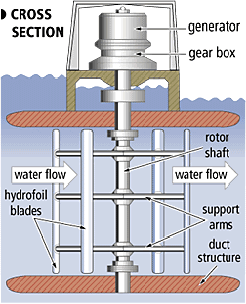
An artist’s rendering of a vertical axis turbine is depicted below:
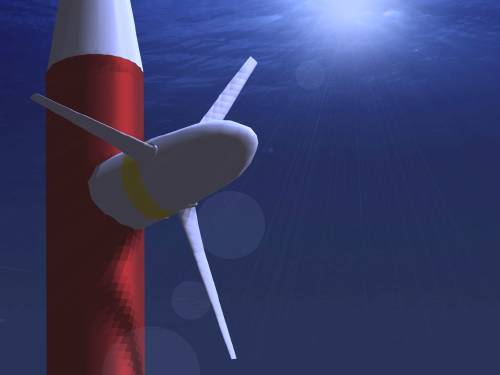
These are accessible technologies and familiar to anyone who has ever seen a windmill in operation. There are some other, more exotic harvest technologies though as well. For instance, the oscillating water column, depicted below:
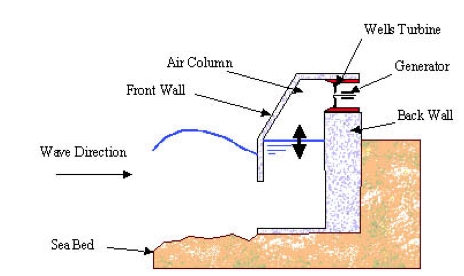
As the wave action occurs, a column of air is compressed in a tight space creating pressure. This air is driven through an efficient turbine as the wave comes in, and sucked back through the same turbine as the wave goes out when a vacuum is created as the wave retreats. This application could be applied on shore or in a floating device.
Another interesting class of harvest device are the pendulors. As the name suggests, there is a pendulum type device that is moved back and forth by wave action. The pendulum (I tend to think of it more as a paddle) is connected to a hydraulic pump which forces a working fluid through a turbine. This application may also be shore-based or floating. An illustration of a shore-based system is available below:
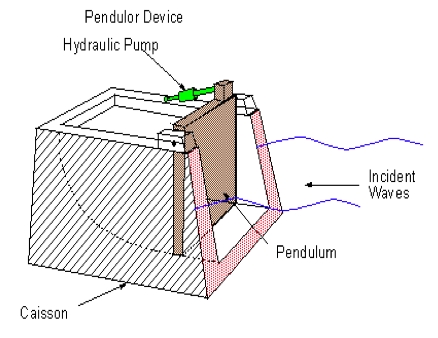
Since the ocean comprises the vast majority of the Earth’s surface area and has nearly unlimited energy, both mechanical and thermal, it makes sense to explore utility scale harvest of the resource. There are some efforts underway, but they pail in comparison to the amount of money being poured into wind and solar projects. This is an interesting opportunity for the right kind of investor….
Court ruling changes economics
From Renewable Energy Access:
Comments are off for this postIn simple terms, the Court rejected arguments by many electric utilities whose power plants were grandfathered into the Clean Air Act, and then maintained that if they upgraded these power plants — they still would not have to meet Clean Air Act standards.
Renewable energy experts hailed the ruling as the first step to force baseload coal plants to invest in meeting emissions standards like all other energy sources — and that these investments will be reflected in increased rates, making baseload renewables such as biopower, concentrated solar, geothermal and wind more competitive.



